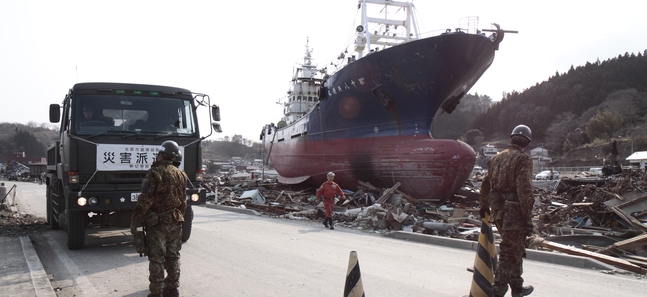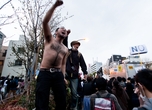
Posted: Thu Apr 14 2011
I'm the host of a music event called Give Me Vegetable, at which punters pay the entry fee in vegetables. On the afternoon of March 29, I received a tweet explaining that there weren't enough fresh vegetables in the Kesennuma shelters, and that more and more people were suffering from malnutrition. I quickly put together an event for April 1, thinking that I could take the vegetables I collected right to the spot where they were needed most. Together, we managed to rustle up nine boxes of veg. After double checking with Nihon no Mori Biomass Network (NMBN, the organisation who sent the initial tweet), and scouting out the petrol situation and road damage for the Miyagi area, I grabbed three hours' kip, then hit the road. It was 3am, April 2 when I left.

Nine boxes of veg, crammed into my car
I got on the Tohoku expressway and headed for the Tsukidate Interchange. There were several places on the way where the road was cracked or buckled. I headed straight to the NMBM supply collection centre in Kurihara, Miyagi, where I met Takahiro Ooba, assistant managing director, who I'd spoken to so often on the phone but never properly met. He said that they'd been focusing on contacting smaller shelters and private homes that had a tendency to be overlooked, finding out what supplies were needed and then delivering the materials individually.

NMBM supply collection centre, Kurihara

Planning board for distribution
And so I set out on the one-hour journey to the shelter in Kesennuma. The roads on the way seemed calm, and I didn’t see any lines of cars at the petrol stations [as the press had reported]. In fact, apart from signs at convenience stores saying there were no cigarettes, at a glance you could barely see any evidence of the earthquake at all. The point where the landscape changed completely was when I drove out of the tunnel on the Kesennuma Bypass and arrived in Nishihachiman-cho. It was a town of rubble, without any trace of what had been there before. With sidelong glances at the scene around me, I hurried to Jonenji, a temple that had become a shelter.

Nishihachiman-cho, Kesennuma: 'A town of rubble'
Taking the supplies inside, I could see futons strewn across the floor and refugees of all ages, from the elderly to little children. They were overjoyed that the vegetables had arrived, and thanked me over and over again. They told me that almost every day their meals consisted of cup noodles, bread and cold onigiri (rice balls), so it would be the first time in 20 days that they had eaten vegetables. Fresh veg is actually popular at any of the evacuation shelters, but because it won’t keep for long, it's difficult to deal with. Other than what the Self-Defence Forces have supplied, greens are rarely distributed, and if you're in a small shelter there's even less chance of getting any.

'It didn’t feel like there was an atmosphere of gloom at all'
It goes without saying that Jonenji still had no electricity or running water. The people were incredibly grateful to be alive and to have food to eat, but it is difficult to live on only cup noodles and bread everyday. That said, a great advert for life in rural areas was the fact that they all knew each other by sight and were helping each other despite these hardships. It didn’t feel like there was an atmosphere of gloom at all. I promised them I would definitely come back, and set out for the Shishiori district: the area that had sustained the most damage from the tsunami.
Tweets
- About Us |
- Work for Time Out |
- Send us info |
- Advertising |
- Mobile edition |
- Terms & Conditions |
- Privacy policy |
- Contact Us
Copyright © 2014 Time Out Tokyo














Add your comment